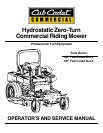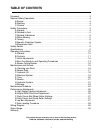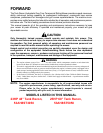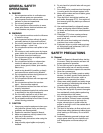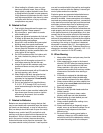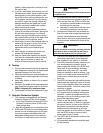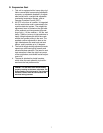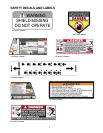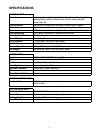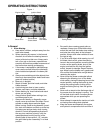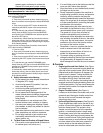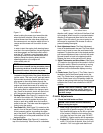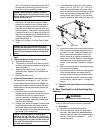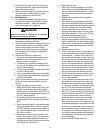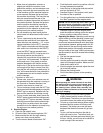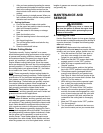
6
position. Always allow other vehicles to have
the right-of-way.
12. If you hit a solid object while mowing, turn off
the blade clutch switch, place the left and right
steering levers in the neutral position, move
the throttle to slow, set the parking brake, shut
off the engine and take the key from the igni
-
tion switch. Inspect for damage. Repair any
damage. Make sure the blades are in good
condition and that the blade bolts are tight
before restarting the engine.
13. Never leave the mower unattended without:
turning off the blade clutch switch; placing the
left and right steering levers in the neutral
position; moving the throttle to slow; setting
the parking brake; shutting off the engine and
taking the key from the ignition switch.
14. Never walk or stand on the discharge side of a
mower with the engine running. Turn off the
blade clutch switch if another person
approaches while you are operating the
mower.
15. Never attempt to operate the traction unit
without the mowing deck attached.
16. Keep the mower and especially the engine
and hydraulic components clean and free of
grease, grass and leaves to reduce the
chance of fire and to permit proper cooling.
E. Towing
1. Tow only with a machine that has an approved
hitch designed for towing. Do not attach towed
equipment except at the hitch point.
2. Follow the manufacturers recommendation for
weight limits for towed equipment and towing
on slopes.
3. Never allow children or others in or on towed
equipment.
4. On slopes, the weight of the towed equipment
may cause loss of traction and loss of control.
Note:
5 degrees (9%) maximum slope.
5. Travel slowly and allow extra distance to stop.
F. Operator Protection System
1. This machine is equipped with an Operator
Protective System (OPS), which includes:
a. A Roll Over Protective Structure (ROPS) or
Operator Protective Device (OPD) of the
fixed configuration
b. Seat belt assembly with retractable function
2. ROPS and OPDs are structures designed to
provide a crush-resistant space for the oper
-
ator when properly seat-belted within the
designated seating area of the machine in
the event of a machine tip-over or roll-over.
DANGER:
Damaged ROPS and OPDs must be replaced prior
to operator use!
3. Seat belts shall be used and shall be prop-
erly fastened about the operator’s waist at all
times, except when the ROPS or OPDs are:
a. not properly installed and/or not properly
secured onto the machine
b. damaged in such manner that their struc-
tural integrity has been compromised
4. Seat belts are attached to the movable por-
tion of the seat when suspension seats are
utilized, and therefore the seat-mounting
base must be secured to its pivot means and
the pivot means latched to the frame of the
machine.
DANGER:
If ROPS and OPDs are missing, seat belts shall not
be fastened. Worn or damaged seat belt assem
-
blies must be replaced prior to operator use.
5. The ROPS and seat belt are integral parts of
this machine and should not be tampered
with, modified in any manner, or removed.
6. The ROPS extends behind the operator posi-
tion, and therefore the operator must be
aware of potential contact of the ROPS with
items such as trees, buildings, doorways,
clothes lines, utility wires, etc., that could
cause the machine to upset or rollover....use
caution in (or avoid) areas where the ROPS
could come in contact with any structures,
trees, etc.
7. The ROPS and seat belt add additional mass
that elevates the machine’s Center of Gravity
(C.G.) which negatively affects the machine’s
stability and traction....use extra caution when
operating on slopes.
8. Inspect the ROPS and seat belt assemblies
on a regular basis for damage and improper
operation....replace all components that are
damaged or are not functioning properly with
authorized replacement parts.
9. Failure to use the seatbelt properly could
result in serious injury or death if an acciden
-
tal overturn occurs. In order for the ROPS to
be effective, the seat belt must be securely
fastened around the operator at all times
when the operator is on the machine. Contact
with the ROPS during an overturn could
cause serious injury or death.
10. The ROPS will not prevent the machine from
upsets or roll overs.
11. Only approved attachments should be used
on this machine.



